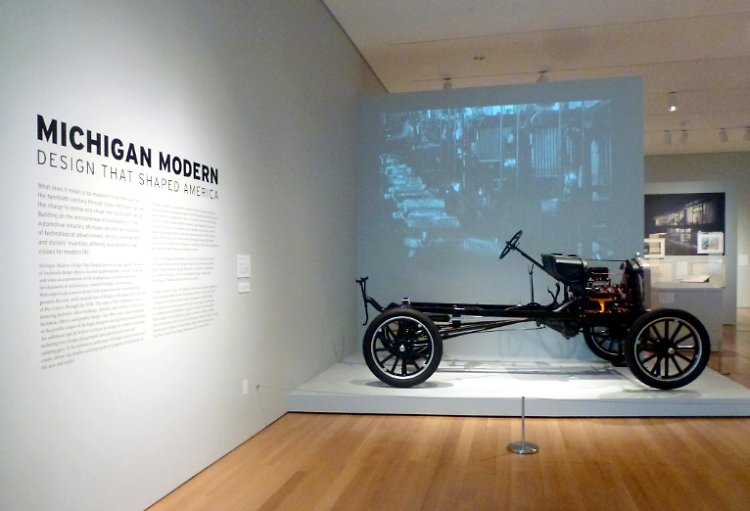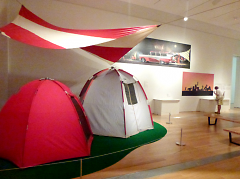Growing up in Michigan I took for granted our state's rich design history, which owes much to forces like the automobile and furniture industries. The influences of companies like Herman Miller and General Motors have echoed across the decades, affecting both our past and present, but their contributions—and, by extension, those of the designers in their employ—are rarely explored in-depth.
The “Michigan Modern: Design that Shaped America” exhibit at the Grand Rapids Art Museum highlights an important aspect of our state's cultural history that should not be overlooked. The exhibit's subject matter is extensive, including cars, architecture, furniture, fabrics, graphic design, boat design, playground equipment and early camping gear.
The exhibit is separated into two levels, with the first floor focusing mainly on Michigan midcentury architecture. On this floor the narrative flows smoothly, opening with a cutaway Ford Model T symbolic of the dawning of Michigan's design prominence. The story of Michigan architecture begins with several Ford plants designed by Albert Khan and concludes with midcentury public housing such as Lafayette Park, designed by Mies van der Rohe.
The second floor contains a number of fascinating subjects, such as tents designed by Detroit native Bill Moss that revolutionized camping in the 1960s and iconic furniture by award-winning Cranbrook designers Charles and Ray Eames and Eero Saarinen. This floor demands the viewer's attention to a greater degree, because there are so many objects in such a small space that it would be easy to miss something.
I particularly enjoyed the section about Harley J. Earl, who founded the General Motors styling department, because my grandfather worked for Earl in the early 1950s. Earl also employed female designers in his department, which was not common in the automobile industry at the time. Nine women hired by Earl in 1955 and nicknamed the “Damsels of Design” played a huge part in designing the aesthetics of the automobiles. They also worked on General Motors exhibitions and the Frigidaire line.
Another intriguing touch is the inclusion of a stretcher and leg splint designed by Charles and Ray Eames for use by the U.S. Military during World War II. These items, found on the first floor, exemplify one of the couple's early forays into experimentation with molded plywood. They were a precursor to the iconic Eames Lounge Chair produced by Herman Miller, which is part of the second-floor exhibition.
This exhibit, currently on display at the Grand Rapids Art Museum, originated at Cranbrook Art Museum. It was a joint effort between Cranbrook, the Michigan State Historic Preservation Office and MPdL Studio of Ann Arbor, Michigan. Upon its move to Grand Rapids, the exhibit was further expanded by the Grand Rapids Art Museum. The organizers did a great job highlighting West Michigan contributions such as Steelcase and Herman Miller, making it more personal to the lives of the people who live here.
The exhibition, as a whole, brings to the forefront a past too often relegated to the background. Michigan's midcentury design prominence is something to be proud of, and exhibits like this help to remind us of our heritage. For anyone who has ever lived in Michigan, has any interest in the history of midcentury modern design, or is simply looking for a fun and educational summer activity, this exhibit should be high on the list.
The exhibit runs until August 24, 2014 and can be found at the Grand Rapids Art Museum, located at 101 Monroe Center NW.
The Rapidian, a program of the 501(c)3 nonprofit Community Media Center, relies on the community’s support to help cover the cost of training reporters and publishing content.
We need your help.
If each of our readers and content creators who values this community platform help support its creation and maintenance, The Rapidian can continue to educate and facilitate a conversation around issues for years to come.
Please support The Rapidian and make a contribution today.


